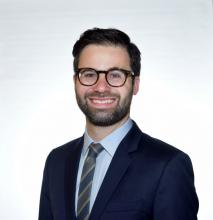After their surgery, 13.1% of opioid-naive patients become new persistent opioid users, and 6.6% of sedative-hypnotic–naive patients become new persistent users of sedative-hypnotics. Risk factors for persistent substance use included younger age, a breast cancer diagnosis, and chemotherapy.
“As the opioid epidemic in the United States continues, the rate of opioid dependence in the cancer population continues to increase as well,” study investigator Jacob Cogan, MD, of NewYork-Presbyterian/Columbia University Irving Medical Center in New York, said during a press conference.
“The perioperative period is one of high risk for cancer patients, with up to 10% becoming new persistent opioid users after cancer-related surgery. The rates surrounding mastectomy and reconstruction, however, are unknown. Another class of controlled substances worth our attention are the sedative-hypnotics. Despite the high rates of psychiatric disorders in the cancer population, there is little research into the rates of persistent sedative-hypnotic use in these patients.”
With this in mind, Dr. Cogan and colleagues analyzed MarketScan health care claims data for patients who underwent mastectomy and reconstruction (whether therapeutic or prophylactic) between 2008 and 2017.
The researchers then identified prescription claims for opioids and sedative-hypnotics during three periods:
- Preoperative period – 365 days to 31 days before surgery.
- Perioperative period – 31 days before to 90 days after surgery.
- Postoperative period – 90 days to 365 days after surgery.
‘Striking’ results
Analyses were based on 25,270 women who were not prior users of opioids and 27,651 women who were not prior users of sedative-hypnotics.
Women were considered new persistent substance users if they had no use in the preoperative period but filled at least one prescription in the perioperative period and at least two in the postoperative period.
Overall, 13.1% of opioid-naive patients became persistent opioid users, and 6.6% of sedative-hypnotic-naive patients became persistent sedative-hypnotic users after their mastectomy and reconstruction.
Proportions of substance use were even higher, 17.5% for opioids and 17.0% for sedative-hypnotics, after excluding women who did not receive or fill a perioperative prescription.
In multivariate analysis, patients were significantly more likely to become new persistent opioid users if they had Medicaid insurance (odds ratio, 2.31), had a breast cancer diagnosis vs a prophylactic indication (OR, 1.44), received chemotherapy (OR, 1.33), and were 50-64 years of age (OR, 1.29) or 49 years or younger (OR, 1.27), compared with 65 years or older.
Similarly, patients were significantly more likely to become new persistent sedative-hypnotic users if they received chemotherapy (OR, 2.24), had Medicaid insurance (OR, 1.85), had a breast cancer diagnosis (OR, 1.79), and were 50 to 64 years (OR, 1.65) or 49 years or younger (OR, 1.79).
Finally, patients’ likelihood of new persistent use increased with their number of risk factors. For persistent opioid use, the odds ratio rose from 2.27 in patients with two risk factors to 6.34 in those with five risk factors. For persistent sedative-hypnotic use, the odds ratio rose from 2.55 to 7.71, respectively.
The observed incidences of new persistent substance use in this patient population are “striking,” according to Dr. Cogan. Although the identified risk factors can help providers spot patients who should be monitored more closely, a proactive, systematic approach to postoperative follow-up for all patients is likely needed.
“When you are seeing patients in follow-up, this is something that you might want to explicitly ask about, for example, and not just assume that the postoperative opioids were taken and then disposed of,” Dr. Cogan recommended. “Ask them, ‘Are you still taking opioids, are you still taking your Ambien or whatever medication you were prescribed?’ That’s something to diligently follow up on and make sure the drug is disposed of, or if it somebody is still taking it, refer them for the appropriate services.”
In addition, patients should be encouraged to use over-the-counter medications as much as possible, he advised.


